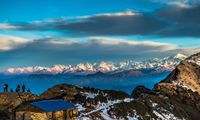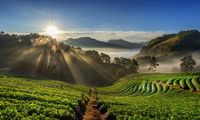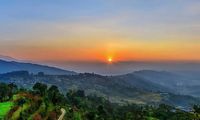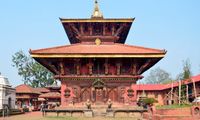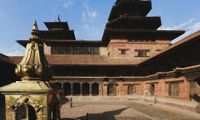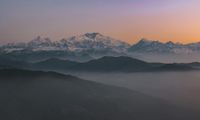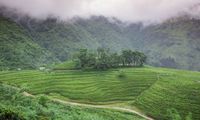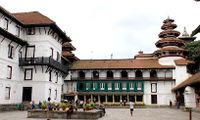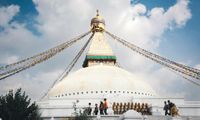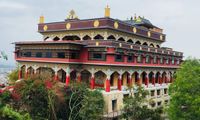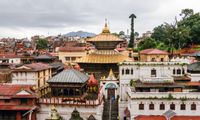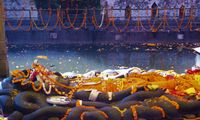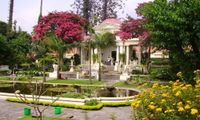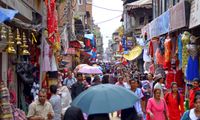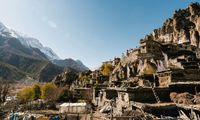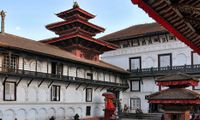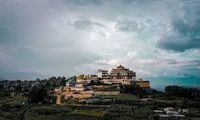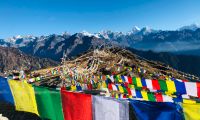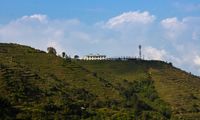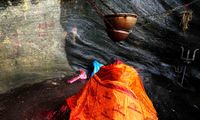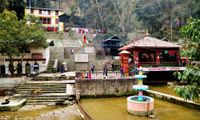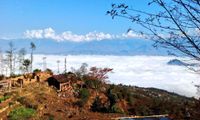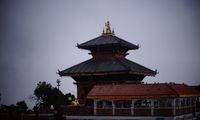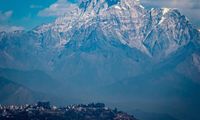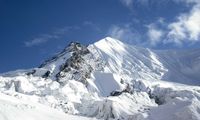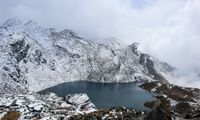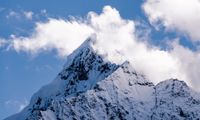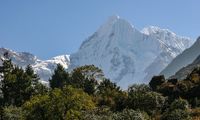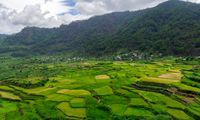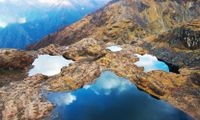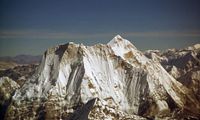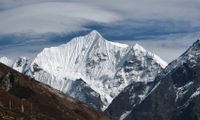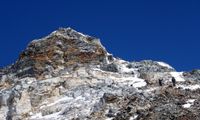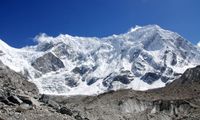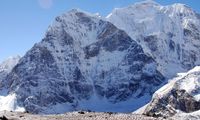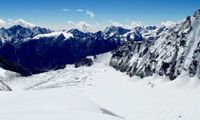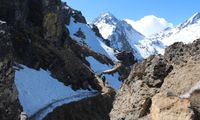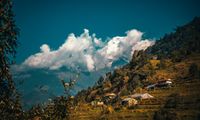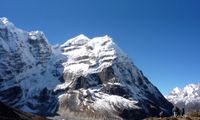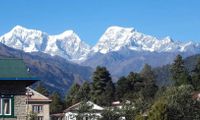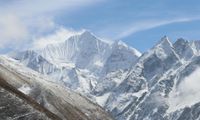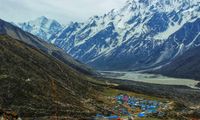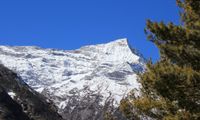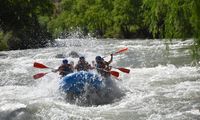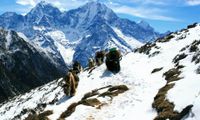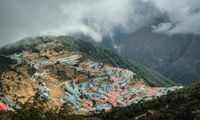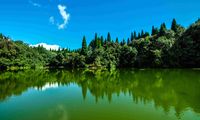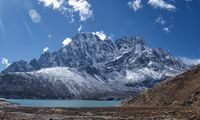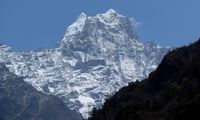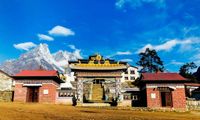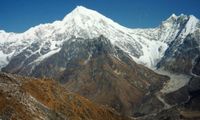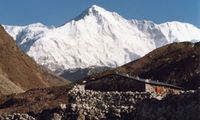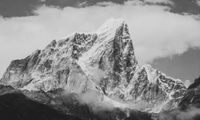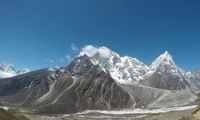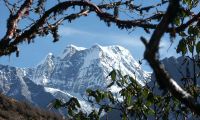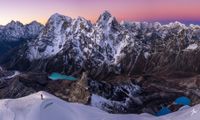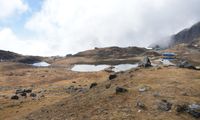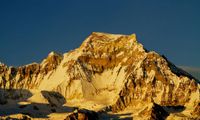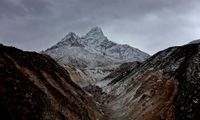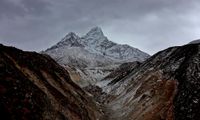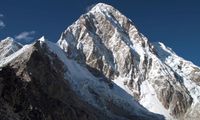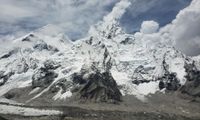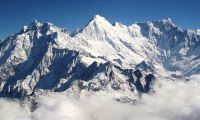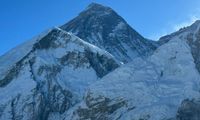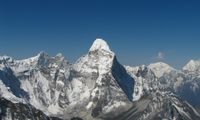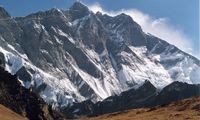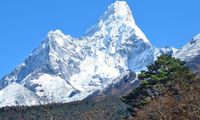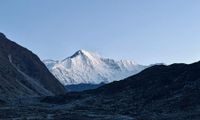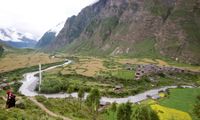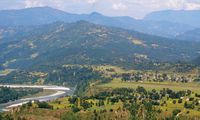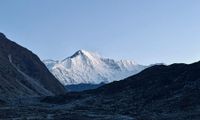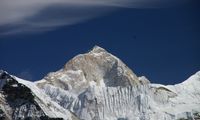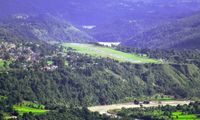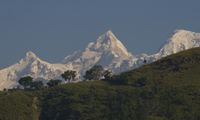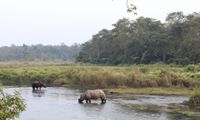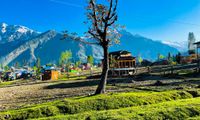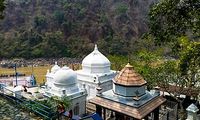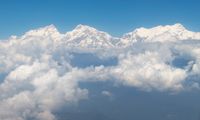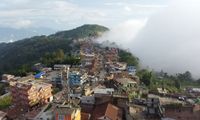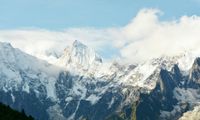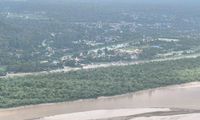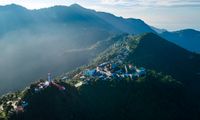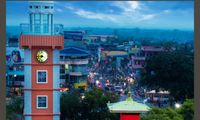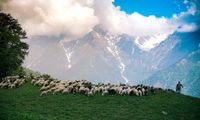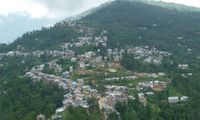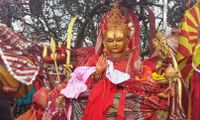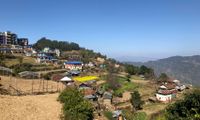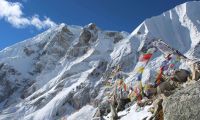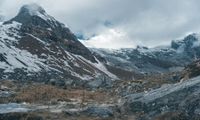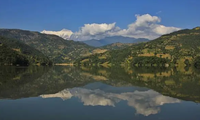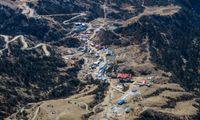Sailung
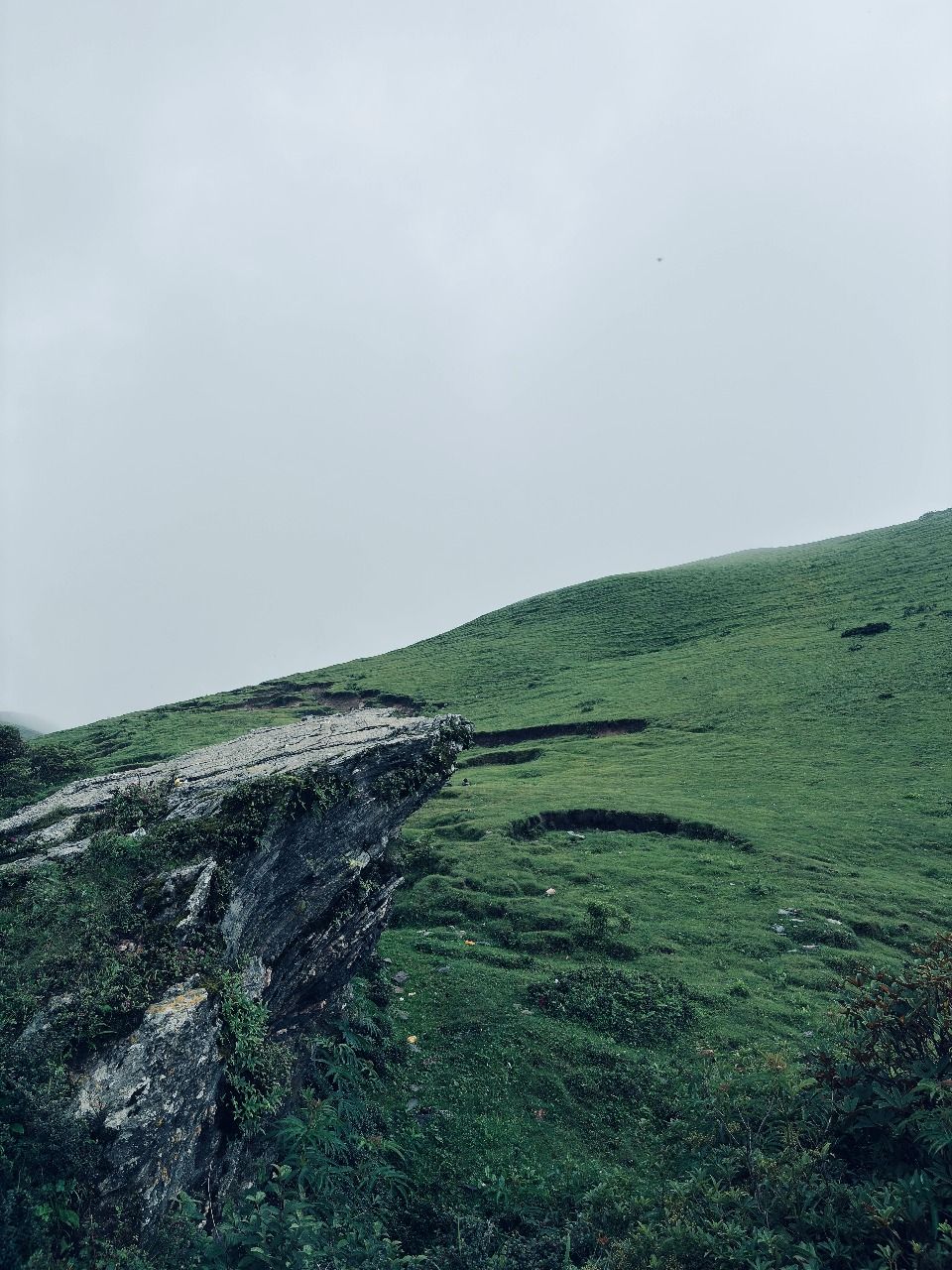
About
Sailung is a serene and spiritually rich trekking destination nestled in the border region of Dolakha and Ramechhap districts of Nepal. Sitting at an altitude of around 3,146 meters, Sailung rewards visitors with panoramic views of over 100 green hillocks and a 360-degree horizon filled with the Himalayan giants, including Mount Everest, Langtang, Rolwaling, and Annapurna ranges.
Sailung is famous for its untouched highland meadows, peaceful walking trails, and a harmonious blend of Buddhist and Hindu culture, Sailung is perfect for trekkers who seek nature’s silence, soulful landscapes, and authentic rural encounters in an offbeat part of Nepal.
Locate Us
Sailung Nepal, one of the most peaceful and offbeat trekking routes in Nepal, is a breathtaking destination perched at 3,146 meters between Dolakha and Ramechhap districts. Known as the “land of a hundred hills,” Sailung trek offers some of the best panoramic Himalayan views in Nepal.
It showcases over 90 peaks including Mount Everest, Annapurna, Dhaulagiri, Langtang, and Gaurishankar. Unlike the popular Everest and Annapurna circuits, this hidden gem provides a truly raw and crowd-free Himalayan experience.
Sailung Dolakha is a sacred hilltop where both Buddhist and Hindu cultures intertwine. The trail takes you through untouched Tamang and Sherpa villages, high-altitude grasslands, and prayer flag-lined ridges. In spring, rhododendrons bloom across the slopes, while winter cloaks Sailung in pure white snow, turning it into one of the most peaceful Himalayan viewpoints. This peaceful hiking trail is ideal for nature lovers, spiritual travelers, and photographers searching for unspoiled beauty.
Locals along the Sailung route offer warm hospitality with traditional dishes like dhido, gundruk, and sel roti, giving trekkers a taste of authentic mountain life. The area also supports community-based tourism, making it a top destination for responsible trekking in Nepal.
Reaching Sailung is simple yet scenic. A 6 to 7-hour drive from Kathmandu to Mude Bazaar, followed by a short uphill hike from Deurali, gets you to the main ridge. This trek is accessible in all seasons, but the best time to visit Sailung is during autumn (October–December) and spring (March–May), when the skies are clear and the mountains glow at sunrise.
If you’re searching for a less crowded trek in Nepal, where you can walk above the clouds, sleep under the stars, and take in Himalayan views in complete silence, Sailung is the perfect choice. It’s not just a destination—it’s an experience of timeless peace, culture, and connection with the mountains.
Where is Sailung Located in Nepal?
Sailung is a peaceful, offbeat trekking destination tucked away between Dolakha and Ramechhap districts in Nepal’s central highlands. Located at an altitude of around 3,146 meters above sea level, it offers majestic views of over a hundred rolling hills and a sweeping 360-degree Himalayan panorama. Known for its spiritual significance, untouched beauty, and quiet mountain trails,
Sailung remains far from the reach of mainstream tourism. Surrounded by traditional villages, misty ridges, and ancient shrines, this hidden gem is ideal for those seeking silence, nature, and authentic Himalayan experiences rooted in both Buddhist and Hindu culture.
Best Time to Visit Sailung – Monthly Weather Guide with Local Insights
Choosing the best time to visit Sailung Nepal is key for a peaceful and scenic trekking experience. Since Sailung sits at an altitude of 3,146 meters and offers 360° views of the Himalayas, the weather shifts dramatically with each season. Here’s a detailed month-by-month breakdown to help you plan your Sailung trek more effectively:
1. Spring (March to May)
Spring is the most magical season to visit Sailung. Wild rhododendrons blanket the hillsides, and the trail glows with blooming flowers and singing birds.
- Clear skies reveal stunning views of Mount Everest, Langtang, Annapurna, and Gaurishankar.
- Temperatures are moderate, ranging from 10°C to 20°C during the day.
- The trails are dry, the air is fresh, and the scenery is vibrant—ideal for photography and spiritual reflection.
- Tamang and Sherpa villages are lively as locals celebrate seasonal rituals and prepare fields for plantation.
Verdict: Best time for clear mountain views, nature, and culture combined.
2. Summer / Monsoon (June to August)
The monsoon season in Sailung is marked by daily rain, cloudy skies, and slippery trails.
- Heavy rainfall often hides the Himalayan views and makes the paths muddy.
- Leeches are common in grassy and forested areas.
- However, the entire landscape turns into a lush green paradise, and cloudscapes across the ridges are mesmerizing.
- This time is suitable for village homestays, cultural research, and community-based tourism rather than trekking.
Verdict: Not ideal for high-altitude trekking, but peaceful for lowland exploration.
3. Autumn (September to November)
Autumn is the most popular season to trek to Sailung due to stable weather and crystal-clear skies.
- After the monsoon, the atmosphere is dust-free, giving unmatched visibility of the entire Himalayan belt.
- Day temperatures are pleasant (12°C to 18°C), while nights are cool.
- It’s the perfect time to witness festivals like Dashain and Tihar, which bring the local culture to life.
- The dry trails and golden light make trekking, photography, and meditation particularly enjoyable.
Verdict: Ideal for a complete Sailung experience—scenery, spirituality, and culture.
4. Winter (December to February)
Winter transforms Sailung into a snowy Himalayan paradise.
- Snowfall creates surreal landscapes with prayer flags fluttering over white ridgelines.
- Daytime temperatures hover around 5°C–10°C, while nights drop below 0°C at the summit.
- Trekkers need proper gear, warm layers, and camping essentials as local tea houses may be closed.
- For snow lovers, this is the best time to visit Sailung without any crowds.
Verdict: Best for solitude, snow photography, and adventure—if you're well-prepared.
Final Weather Tips for Sailung Nepal Visitors:
- Always check the latest Sailung weather forecast before departure.
- Avoid the monsoon season if your goal is panoramic mountain views and summit trekking.
- Layered clothing, waterproof gear, and warm sleeping bags are must-haves year-round.
- Plan 2–3 days minimum to enjoy sunrise, sunset, spiritual walks, and cultural immersion.
- Carry a local guide or join a community-based trekking group for safety and local support.
Weather: A Typical Day in Sailung
A typical day at Sailung offers a refreshing mountain atmosphere, shaped by its high-altitude location (around 3,146 meters) in Nepal’s Dolakha and Ramechhap districts. Known as one of the best offbeat trekking destinations in Nepal, Sailung’s weather plays a crucial role in planning your perfect hike.
Morning: Mornings at Sailung are usually cold and misty. Temperatures range from 4°C to 10°C, especially during spring and autumn—the best seasons for Sailung trekking. The sun slowly rises above the hills, casting golden light over prayer flags and rhododendron-covered slopes, creating perfect conditions for sunrise photography and early morning meditation.
Afternoon: The temperature warms slightly, averaging 12°C to 18°C. This is the best time for trekking, enjoying clear panoramic views of the Himalayas including Mount Everest, Langtang, and Annapurna. Skies are often clear, offering excellent visibility that attracts many seeking the best mountain views near Kathmandu. The pleasant afternoon climate also makes it ideal for nature walks and exploring Sailung’s sacred sites.
Evening: As the sun sets, temperatures drop quickly below 5°C, and the chill returns. The nights can get freezing, especially in winter, with frost or snow depending on the season. Evening is perfect for relaxing in local homestays, experiencing traditional food, and preparing for next day’s hike.
Monthly Weather Overview
January – February (Winter): Coldest months with temperatures often below freezing at night. Snow may cover higher trails, making winter trekking in Sailung a unique adventure for experienced trekkers. Daytime is crisp but chilly, perfect for those who enjoy peaceful snowy landscapes.
March – May (Spring): One of the best times to visit Sailung. Temperatures gradually rise, rhododendron flowers bloom, and skies are mostly clear. This season is popular among travelers searching for best trekking in Nepal in spring. Daytime temperatures range from 10°C to 18°C, ideal for comfortable hiking and sightseeing.
June – August (Monsoon): Heavy rains and frequent clouds make trekking difficult. Trails become slippery and risky due to landslides. Not recommended for trekking during this time, but monsoon village tours in Sailung can still be enjoyable for cultural enthusiasts.
September – November (Autumn): Another prime trekking season with stable weather, clear blue skies, and excellent mountain visibility. This period is considered the best time for Sailung trek with the clearest Himalayan views. Temperatures range between 10°C and 18°C during the day, offering perfect trekking conditions.
December (Early Winter): Cool and dry with clear skies. Nights become very cold, and snow may begin to accumulate at higher elevations. This season is great for those interested in quiet winter trekking and capturing crisp, snow-capped mountain photos.
Weather at Sailung can change rapidly, so it’s essential to carry layered clothing, windproof jackets, and rain protection at all times. Whether you’re planning a short day hike or a longer Sailung trekking tour, preparing for weather variations ensures a safe and enjoyable trip.
Height and Altitude of Sailung
Sailung, locally known as Sailung Danda, stands tall at an altitude of approximately 3,146 meters (10,322 feet) above sea level. This serene hilltop lies at the border of Dolakha and Ramechhap districts in Nepal and is part of the pristine mid-hill region that offers spectacular Himalayan vistas.
The elevation of Sailung makes it an ideal high-altitude viewpoint that is accessible to moderately fit trekkers and nature lovers. Sitting below the more extreme Himalayan altitudes of 4,000 meters, Sailung allows visitors to enjoy breathtaking views of towering peaks such as Mount Everest, Langtang, Annapurna, and Gaurishankar without requiring intense acclimatization or technical climbing experience.
Despite its respectable height, the trail to Sailung is considered gentle and less crowded compared to popular trekking routes in Nepal. This altitude supports rich biodiversity, featuring lush alpine meadows, blooming rhododendrons in spring, and occasional snowfall during winter months, all complemented by fresh, crisp mountain air year-round.
Whether you are trekking for spiritual solace, adventure, or landscape photography, the altitude of Sailung provides a perfect balance of stunning panoramic views and a tranquil highland atmosphere, making it a must-visit hidden gem among Nepal’s offbeat trekking destinations.
How to Get to Sailung?
Reaching Sailung, one of Nepal’s best hidden trekking gems, is an adventurous and scenic journey through the Dolakha and Ramechhap districts—perfect for travelers seeking offbeat trekking in Nepal. This peaceful highland destination offers breathtaking panoramic views of the Himalayas and authentic cultural experiences in rural villages.
From Kathmandu to Mude Bazaar:
The most common starting point for the Sailung trek is Mude Bazaar, accessible by a 6 to 7-hour drive from Kathmandu, Nepal’s capital city. You can hire a private jeep or take a local bus for this journey. The road passes through picturesque hills, terraced farmland, and traditional Tamang and Sherpa villages, giving you a glimpse of rural Nepal life even before the trek begins. The road condition can be rough in some sections, so using a reliable 4x4 vehicle or jeep is recommended for comfort and safety.
For travelers preferring quicker access, it’s possible to fly from Kathmandu to nearby Charikot Airport, which is about 1 to 1.5 hours by road to Mude Bazaar. However, domestic flights can be irregular, so road travel remains the most dependable option.
From Mude Bazaar (or Deurali) to Sailung Ridge:
The trekking route starts from Mude Bazaar or the nearby village of Deurali. This moderately challenging hike takes you through lush rhododendron forests, peaceful Sherpa and Tamang villages, and expansive alpine meadows often called the “land of 100 hills.” The trail is ideal for those looking for easy to moderate trekking near Kathmandu, offering a perfect balance of nature, culture, and mountain views.
Along the trail, you’ll encounter traditional homestays and tea houses, where you can savor authentic Nepali cuisine such as dal bhat, sel roti, and local herbal teas. This community-based trekking supports sustainable tourism and provides a deep cultural immersion experience.
The final ascent leads to the Sailung viewpoint, perched at around 3,146 meters, where you can witness breathtaking 360-degree views of the Himalayan giants including Mount Everest, Langtang Himal, Annapurna, and Gaurishankar ranges—some of the best mountain views in Nepal accessible without extreme altitude trekking.
Alternative Routes and Transport Options:
For those who prefer, the trek can also begin from nearby towns like Charikot or Dolakha Bazaar, with local transport options to Mude Bazaar. Travelers can customize their journey with day hikes or overnight camping, depending on their fitness level and time availability.
Trekking Difficulty
The Sailung trek is considered a moderate-level trek, making it accessible for beginners and experienced hikers alike, but here are some details to help you prepare:
- Trail Conditions: The trails are mostly well-marked and pass through forested areas, open meadows, and rural villages. Some sections involve gradual ascents and descents but are not overly steep or technical.
- Altitude: At about 3,146 meters at the highest point, Sailung doesn’t require extensive acclimatization like higher Himalayan treks. However, trekkers should still be aware of altitude sickness symptoms and prepare accordingly.
- Fitness Level: A moderate fitness level is recommended. Regular walking or hiking experience helps, but the trek can be completed comfortably by those with average fitness.
- Duration and Pace: The trek typically takes 3 to 4 days, allowing ample time to acclimate and enjoy the scenery without rushing.
- Weather Considerations: Weather changes can affect trail conditions, so appropriate gear and clothing are essential for safety and comfort.
Travel Cost for Sailung from Kathmandu
Sailung, a stunning highland destination nestled in the border of Dolakha and Ramechhap districts, is gaining popularity for its panoramic Himalayan views and spiritual essence. Here's a detailed breakdown of travel costs from Kathmandu to Sailung to help you plan your trip efficiently:
1. Transportation Costs
Option A: Local Bus (Budget-Friendly)
- Kathmandu to Mude (via Charikot): NPR 500 - 700 per person
- Mude to Dhunge (Sailung trailhead): NPR 300 - 400 per person
- Total Local Bus Cost: NPR 800 - 1,100 per person (one-way)
Option B: Reserved Jeep (Comfortable & Time-Saving)
- Kathmandu to Dhunge (direct): NPR 12,000 - 15,000 per Jeep (fits 6-8 people)
- Per Person Cost (sharing among 7): NPR 1,700 - 2,200
2. Accommodation Costs
- Basic Tea House or Local Homestay: NPR 500 - 800 per night (per person)
- Camping (own tent): Free or minimal fee (some landowners may ask NPR 100-200)
3. Food & Beverage
- Local Dal Bhat or Noodles: NPR 200 - 350 per meal
- Snacks/Tea/Drinks: NPR 50 - 150 each
- Daily Meal Budget: NPR 600 - 1,000 per person
4. Guide or Porter (Optional)
- Local Guide Fee: NPR 2,000 - 3,000 per day
- Porter (if carrying camping gear): NPR 1,500 - 2,000 per day
5. Miscellaneous Expenses
- Entry Fees: Usually none
- Tips, Personal Supplies, or Shopping: NPR 500 - 1,000
Estimated Total Cost (2-day trip):
Budget Trip (Local Transport, Basic Stay, No Guide):
- NPR 2,500 - 3,500 per person
Comfort Trip (Jeep Ride, Guide, Homestay):
- NPR 5,000 - 7,000 per person
Tips to Save More:
- Travel in a group to split Jeep or guide costs
- Carry refillable water bottles and dry snacks
- Book homestays in advance to ensure availability
Sailung is not only budget-friendly but also deeply rewarding for travelers who love offbeat paths and nature-rich experiences. Always check road and weather conditions before your journey!
Related Treks Starting from Sailung
If you’re exploring off-the-beaten-path treks in Nepal, the serene and scenic Sailung trek area in Dolakha and Ramechhap districts offers some of the most beautiful and less crowded trekking routes in the Himalayas. Trekkers looking for authentic Nepal trekking experiences and panoramic mountain views will find these trails perfect for their next adventure. Here are three exceptional treks starting from Sailung that highlight the best of Nepal’s natural beauty and cultural richness:
1. Classic Sailung Trek (4–5 Days):
The Sailung trekking route from Mude Bazaar is ideal for those seeking moderate treks with stunning Himalayan vistas. This trail passes through rhododendron forests in Nepal, traditional Tamang and Sherpa villages, and expansive alpine meadows. You’ll experience panoramic views of iconic mountains such as Mount Everest trekking region, Langtang National Park, Gaurishankar Conservation Area, and the Annapurna mountain range. This trek is well-known for its tranquility and cultural immersion, making it a top choice for nature lovers and photographers searching for peaceful trekking near Kathmandu.
2. Sailung to Charikot Loop Trek:
The Charikot loop trek beginning and ending near Sailung offers an exceptional mix of cultural trekking in Nepal and natural beauty. This loop trail explores Nepali hill villages, terraced farmland, and dense forest areas, providing trekkers with authentic encounters with Newari and Tamang cultures. The trek is perfect for those interested in cultural tours in Nepal combined with scenic hiking. Visitors enjoy tasting local Nepali cuisine, attending village festivals, and capturing panoramic views of the Himalayan mountain ranges along the way.
3. Sailung Ridge to Gaurishankar Base Camp Trek:
For experienced trekkers seeking remote and challenging routes, the Gaurishankar Base Camp trek from Sailung offers an unforgettable Himalayan adventure. The route passes through protected areas within the Gaurishankar Conservation Area, known for its diverse wildlife and stunning mountain landscapes. This trek provides rare access to remote Himalayan villages and unparalleled views of Mount Gaurishankar, a sacred peak in Nepal. It is a favored trail for those who want to explore less frequented parts of the Nepal trekking circuit and connect with pristine nature.
Things to Do in Sailung – Culture, Nature, and Local Living
Sailung Danda is a peaceful highland destination near Kathmandu, ideal for trekkers, nature lovers, and cultural explorers searching for authentic off-the-beaten-path trekking in Nepal. Whether you’re after spectacular Himalayan panoramas or immersive local experiences, here’s what makes the Sailung trek truly unforgettable:
1. Trekking and Scenic Hiking
The Sailung trek is perfect for those looking to escape crowded trails and experience peaceful Nepal trekking near Kathmandu. The route takes you through dense rhododendron forests, rolling alpine meadows, and traditional Tamang and Sherpa villages. Expect jaw-dropping views of iconic peaks like Mount Everest, Langtang Himal, Gaurishankar, and Annapurna, all from the stunning Sailung ridge.
2. Nature Exploration and Birdwatching
Sailung’s rich biodiversity makes it a hotspot for birdwatching in Nepal and nature enthusiasts. Spot colorful Himalayan birds such as the satyr tragopan and Himalayan monal. During spring, vibrant rhododendrons bloom along the trail, attracting photographers and naturalists eager to capture Nepal’s unique flora and fauna
3. Meditation and Peaceful Solitude
If you’re asking, “Where can I find peaceful trekking spots near Kathmandu for meditation?”, Sailung is the answer. The tranquil environment, fresh mountain air, and panoramic views create a perfect setting for mindfulness, yoga, and meditation retreats away from tourist crowds.
4. Camping Under the Himalayan Stars
Sailung offers incredible opportunities for camping in Nepal’s Himalayas. Spend your nights under clear skies filled with stars, enjoy campfires, and experience the serenity of the mountains in complete solitude — a perfect activity for adventure lovers and nature photographers alike.
5. Experience Local Culture and Traditions
Though Sailung ridge itself is uninhabited, nearby villages are rich with cultural heritage, offering authentic insights into Tamang and Sherpa lifestyles. Here’s what you can experience:
- Traditional Dance and Music: Witness vibrant Tamang and Sherpa folk dances and musical performances during local festivals, a highlight for cultural travelers.
- Local Language and Folklore: Learn simple Tamang phrases and hear traditional stories and legends that reveal the region’s spiritual history.
- Handicrafts and Souvenirs: Purchase handmade woolen clothes, jewelry, and crafts directly from local artisans, supporting sustainable tourism.
- Warm Homestay Hospitality: Stay with welcoming families in village homestays, savor traditional meals like gundruk, dhido, and freshly brewed milky tea, and enjoy genuine Nepali hospitality.
Whether you’re wondering, “What is the best trekking near Kathmandu for nature and culture?” or seeking an offbeat Himalayan adventure, Sailung offers the perfect blend of breathtaking views, rich biodiversity, and immersive cultural experiences. It’s an ideal destination for photographers, birdwatchers, spiritual seekers, and anyone wanting to explore authentic Nepal away from the crowds.
Where to Stay in Sailung?
When trekking to Sailung Danda, accommodation options are simple but offer authentic experiences that connect you with local culture and nature. As Sailung is a less-commercialized trekking destination near Kathmandu, travelers can choose from homestays, guesthouses, camping, and nearby motels or hotels for convenience.
Homestays:
For those wanting to experience genuine Tamang and Sherpa culture, homestays in nearby villages like Chandanbari, Goth Gaun, and Mude Bazaar are excellent choices. These community-run homestays provide clean rooms, warm hospitality, and homemade Nepali meals featuring local favorites such as gundruk, dhido, and fresh vegetables. Staying in homestays offers travelers the chance to enjoy traditional music, dance performances, and firsthand cultural exchange with local families. Homestays are affordable and support sustainable tourism by directly benefiting the local community.
Guesthouses:
Along the Sailung trekking route, a handful of small family-run guesthouses provide comfortable lodging with basic amenities such as hot meals and clean bedding. These guesthouses offer a restful environment for trekkers after a long day on the trail, combining convenience with the warmth of rural Nepali hospitality. Although limited, guesthouses in the Sailung region contribute to growing tourism infrastructure and serve as reliable accommodation options.
Camping:
At the Sailung ridge itself, permanent lodges or tea houses are rare or nonexistent. Most trekkers opt to camp overnight, bringing tents and sleeping bags or hiring guides who provide camping gear. Camping at Sailung offers a magical experience beneath clear Himalayan skies, ideal for stargazing, photography, and fully immersing in the serene mountain atmosphere. Camping requires good preparation but gives freedom and a closer connection to nature, popular among adventure seekers and nature lovers.
Motels and Hotels Nearby:
For travelers preferring more comfort before or after the trek, motels and hotels are available in nearby towns like Charikot and Dhulikhel. These towns, just a few hours’ drive from Sailung, offer a variety of accommodations ranging from budget-friendly lodges to mid-range hotels with modern amenities. Staying in these towns is convenient for rest, shopping, and preparing for the trek. Although not on the trekking trail itself, they serve as excellent base points for exploring the Sailung area.
Do You Need a Permit for Sailung?
One of the most common questions about trekking to Sailung Danda is whether a permit is required. Currently, there is no special trekking permit needed for Sailung, unlike restricted regions such as Manaslu or Upper Mustang. This makes Sailung an accessible and budget-friendly trekking option near Kathmandu.
However, it’s advisable to check with the local tourism office in Dolakha or Charikot for the latest updates on trekking regulations. If you hire a local guide or stay in registered homestays, most permit-related formalities are typically handled on your behalf.
For safety and accountability, always register your name and trekking itinerary at the nearest checkpoint or village, especially if you plan to trek independently without a guide.
Is Sailung Safe for Solo Travelers?
Sailung trekking is generally considered safe for solo travelers, but a few important precautions should be noted. Since it is an off-the-beaten-path trail, the routes might be less marked and fewer trekkers pass through compared to popular trails like the Everest Base Camp trek or Annapurna Circuit.
For solo trekking, hiring a local guide or porter from nearby villages such as Chandanbari or Mude Bazaar is highly recommended. This not only enhances your safety but also enriches your experience through local stories, cultural insights, and expert navigation.
Be sure to carry essential trekking gear, including enough water, snacks, first-aid supplies, a flashlight, a portable charger, and a physical or digital map. Mobile network coverage may be patchy in some areas, so inform someone about your trekking plan and expected return time.
Native Vegetation and Medicinal Herbs Found in Sailung, Nepal
Sailung, located in the Dolakha and Ramechhap districts of Nepal, is not only famous for its panoramic Himalayan views but also for its rich biodiversity. The region is home to a variety of alpine and subalpine vegetation, seasonal flowers, and rare medicinal herbs that contribute to its ecological and cultural significance.
Here are some of the key herbs and plants found in the Sailung region:
1. Laligurans (Rhododendron):
The national flower of Nepal, Laligurans blooms vibrantly across the hills of Sailung in spring. Its bright red blossoms are not only visually stunning but are also believed to have anti-inflammatory properties.
2. Chimal Gurans:
Another variant of rhododendron, Chimal Gurans features pink or white flowers. It grows in higher altitudes and contributes to the unique floral diversity of Sailung.
3. Gobre Salla (Pinus wallichiana):
Commonly known as Blue Pine, Gobre Salla is widely found in the mid-hill forests. The resin from this tree is used in traditional medicines for respiratory issues.
4. Thangre Salla:
A native pine species that provides shelter for local wildlife and is valued for its timber. It thrives well in the cold climate of Sailung.
5. Khanu:
Khanu is a local herb used in traditional remedies for treating fever and skin infections. It typically grows on damp forest floors.
6. Asare:
This herb sprouts during the monsoon and is known for its use in Ayurvedic treatments, especially for digestive ailments.
7. Shailunge Phul:
This flower is unique to the region and shares its name with Sailung. Its rarity and fragrance make it culturally symbolic among locals.
8. Jatamasi (Spikenard):
A highly prized medicinal herb, Jatamasi is used to relieve stress, improve sleep, and balance hormones. It is often harvested sustainably due to its economic and therapeutic value.
9. Padamchal:
Often found in moist forest areas, Padamchal is recognized for its natural healing properties and is used in herbal teas.
10. Thulo Okhti:
This large-leafed plant is used in rural Nepalese households for treating wounds and bruises. Its roots are believed to have anti-bacterial properties.
11. Delling:
A seasonal herb known for its pleasant smell. Locals sometimes use its leaves for making herbal incense or natural dyes.
12. Hiremire:
Hiremire is a wild herb with potential medicinal uses, though it’s mainly recognized for its role in sustaining local wildlife ecosystems.
13. Sisnu (Stinging Nettle):
Though painful to touch, Sisnu is rich in nutrients. It is consumed as soup or saag in local diets and also used in folk medicine for arthritis and allergies.
14. Kukur Paile:
This aromatic herb is used for its antiseptic and insect-repelling qualities. It is often crushed and applied to wounds.
15. Pahelo Phul (Yellow Flower):
These small yellow flowers bloom during the spring and are known for attracting bees and butterflies. Some are used in herbal tonics.
16. Lalgedi:
A native flowering herb with cultural importance. It’s used during religious offerings and believed to purify spaces.
17. Akselahara:
A less common herb used in local remedies. It grows in shaded forest patches and is believed to relieve stomach disorders.
18. Bhale Ghiraila:
A local flowering shrub with beautiful bell-shaped flowers. It grows at higher altitudes and adds color to the trekking trails.
19. Dhasingi:
Another wild herb that grows in the rocky terrain of Sailung. Used by locals for brewing herbal infusions believed to improve immunity.
Which Trek Should You Choose: Sailung or Kalinchowk?
Choosing between the Sailung Trek and the Kalinchowk Trek depends on your preferences, trekking experience, and what kind of adventure you’re seeking in Nepal’s Dolakha region.
Choose Sailung If You Want:
- A peaceful, off-the-beaten-path trekking experience away from crowds.
- Moderate trekking difficulty suitable for beginners, families, or casual hikers.
- Stunning panoramic views of multiple Himalayan ranges including Everest, Annapurna, Langtang, and Manaslu.
- Immersion in authentic Tamang and Sherpa village culture with homestays and local festivals.
- Trekking during spring or autumn to enjoy rhododendron blooms and clear mountain skies.
- Opportunities for nature photography, birdwatching, and tranquil moments in untouched nature.
Choose Kalinchowk If You Want:
- A shorter but more challenging trek with steeper ascents.
- To visit the famous Kalinchowk Bhagwati Temple and experience a vibrant pilgrimage site.
- Winter trekking with snow-covered landscapes and even skiing or snowboarding options.
- A bustling trekking route during religious festivals and winter months.
- Accommodation close to the temple with guesthouses and lodges.
- A mix of adventure trekking and spiritual or cultural pilgrimage experience.
If you seek solitude, cultural depth, and scenic mountain views without intense physical challenge, Sailung Trek is your ideal choice. But if you prefer a spiritually enriching pilgrimage trek combined with winter sports and more physical challenge, Kalinchowk Trek is perfect.
Both treks showcase Nepal’s natural beauty and cultural richness, making either a rewarding Himalayan adventure close to Kathmandu.
Nearby Attractions and Villages Around Sailung – Explore Dolakha’s untouched places
When trekking to Sailung Danda, you get more than just stunning mountain views—this region is dotted with vibrant villages and exciting nearby attractions that enrich your Nepal trekking experience.
1. Charikot – The Gateway to Sailung Trek:
Charikot is the main town in Dolakha district and serves as the starting point for many treks, including Sailung. Known for its warm hospitality and bustling local markets, Charikot offers a glimpse into rural Nepali life. It’s also a great place to experience traditional festivals and taste authentic Tamang and Newar cuisines.
2. Mude Bazaar – Cultural Hub:
Located en route to Sailung, Mude Bazaar is a lively village famous for its local crafts, traditional markets, and community festivals. Visitors can enjoy local homestays here and witness the colorful Tamang cultural performances that are vibrant and unique to the region.
3. Dolakha Bhimsen Temple:
Just a short drive from Charikot, the ancient Dolakha Bhimsen Temple is a revered religious site dedicated to Bhimsen, a deity worshipped for strength and protection. The temple’s intricate wood carvings and spiritual atmosphere attract pilgrims and tourists alike.
4. Kalinchowk Bhagwati Temple:
While technically a separate trek, Kalinchowk Temple is close enough for a day trip from Sailung. It’s a popular pilgrimage destination known for spectacular mountain views and winter snow activities. Visiting Kalinchowk adds a spiritual and adventurous dimension to your Dolakha journey.
5. Jhule Suspension Bridge – Adventure and Views:
Not far from Sailung, the Jhule Suspension Bridge offers thrilling views and a unique way to experience the region’s natural beauty. It’s a must-visit for adventure enthusiasts and photographers looking to capture dramatic landscapes.
6. Nearby Villages: Tamang and Sherpa Hospitality:
Villages like Chandanbari and Chumling near Sailung are renowned for their warm local hospitality. Staying in community-run homestays here lets travelers immerse themselves in Tamang and Sherpa culture—learning traditional crafts, listening to folk songs, and tasting homemade local dishes.
These attractions and villages offer cultural depth, spiritual experiences, and natural beauty that perfectly complement the Sailung trek. By exploring these hidden gems, travelers enjoy a richer, more immersive journey in one of Nepal’s least commercialized yet most enchanting regions.
Local Insights That Make Sailung Unique
Spring Blossoms: Rhododendrons and Alpine Wildflowers
Every spring, Sailung transforms into a vibrant canvas as the hills burst into color with blooming rhododendrons, primulas, and a variety of delicate alpine wildflowers. These bright blossoms create breathtaking landscapes that attract nature photographers and trekking enthusiasts alike, making spring the most enchanting season to experience the Sailung trek.
Wildlife Encounters: Red Pandas, Himalayan Monals, and Himalayan Tahr
The lush forests and alpine pastures surrounding Sailung are home to diverse wildlife. Trekkers may catch glimpses of the elusive red panda in the dense undergrowth or spot the dazzling Himalayan monal—the national bird of Nepal—flitting across the trees. The rugged terrain also shelters Himalayan tahr, while raptors soar overhead, enhancing the natural allure of the region.
Folklore and Spirituality: Sacred Grounds of the Tamang People
Local Tamang communities around Sailung regard the hills as sacred, believing the area to be blessed by ancient mountain spirits. Traditional stories recount how sages and monks once meditated on these tranquil ridges, adding a spiritual dimension to the trekking experience. This connection to ancient beliefs imbues Sailung with a peaceful, mystical atmosphere that invites reflection and mindfulness.
Festivals: Tamang Losar – The New Year Celebration
Near Sailung, the vibrant Tamang villages celebrate Tamang Losar, the Tamang New Year, with colorful rituals, traditional music, and energetic dances. Trekkers visiting during this festival can witness firsthand the rich cultural heritage of the Tamang people, joining in festivities that showcase traditional costumes, local cuisine, and joyful community spirit.
Is Sailung Worth Visiting?
Absolutely, Sailung is a must-visit destination for trekkers and travelers seeking an authentic and tranquil Himalayan experience near Kathmandu. Unlike popular trekking routes that attract large crowds, Sailung offers peaceful trails rich in natural beauty and cultural heritage. At an elevation of around 3,500 meters, Sailung rewards visitors with sweeping panoramic views of towering Himalayan peaks including Everest, Annapurna, and Langtang.
The trek passes through lush rhododendron forests, alpine meadows, and traditional Tamang and Sherpa villages, providing an immersive cultural experience alongside breathtaking landscapes. Whether you are a nature lover, photographer, spiritual seeker, or a hiker who prefers less crowded paths, Sailung offers a unique combination of solitude, scenic diversity, and warm local hospitality.
For those interested in sustainable tourism, Sailung’s community-run homestays and eco-friendly trekking options make it an ideal place to connect deeply with Nepal’s mountain culture while supporting local livelihoods. Overall, Sailung stands out as a hidden gem offering a meaningful, peaceful, and unforgettable Himalayan adventure.
Sailung Travel Tips –
Preparing well for your Sailung trek ensures a safe, enjoyable, and memorable Himalayan adventure close to Kathmandu. This guide covers important tips on fitness, packing, accommodation, navigation, permits, and connectivity to help you make the most of your journey through Nepal’s hidden mountain gem.
Fitness Level:
- Moderate fitness is enough for Sailung trek’s mixed terrain and altitude (~3,500 meters).
- Prepare with cardio exercises like hiking, jogging, or cycling before your trip.
- Use trekking poles to reduce knee pressure and improve balance.
- Pace yourself, stay hydrated, and monitor for altitude sickness symptoms.
Packing Essentials:
- Layered clothing is a must: moisture-wicking base layers, insulating mid-layers, waterproof outerwear.
- Waterproof, comfortable, and well-broken-in trekking boots are essential.
- Carry a reusable water bottle and water purification tablets or filters.
- Pack a first-aid kit with altitude sickness medication, painkillers, bandages, and blister treatment.
- Bring high-energy snacks like nuts, energy bars, and dried fruits for trail sustenance.
Navigation:
- Trails are moderately marked but hiring a local guide is strongly recommended for safety and cultural insights.
- If trekking independently, download offline maps (Maps.me, AllTrails) and carry a physical map.
- Inform local tourism offices or homestays about your trekking itinerary before departure.
Accommodation:
- Homestays in Tamang and Sherpa villages around Sailung offer authentic cultural experiences and traditional Nepali meals.
- Guesthouses provide basic comfort, clean rooms, and warm hospitality.
- Camping is possible but requires bringing your own gear and permits from local authorities.
Permits:
- No special trekking permits are required for Sailung, unlike Annapurna or Everest regions.
- Always register your trekking plans at local checkpoints or with the Dolakha Tourism Office for safety.
- Local guides often handle permit formalities and registration.
Connectivity:
- Mobile network coverage is patchy and often unavailable at higher altitudes.
- Carry a power bank and inform someone of your route and expected return time.
- Some homestays provide limited Wi-Fi access.
- For emergencies, consider renting a satellite phone or GPS tracker.
Weather & Season:
- The best seasons are spring and autumn for clear skies and blooming rhododendrons.
- Prepare for sudden weather changes with rain gear and warm layers.
Local Culture:
- Respect local customs, dress modestly, and ask permission before photographing villagers.
- Participating in local festivals like Tamang Losar adds richness to your trek experience.
Transportation:
- Reach Sailung via Kathmandu to Charikot by bus or jeep, then local transport to trailheads.
- Pre-book transport options, especially during peak trekking seasons.
Cash & Expenses:
- ATMs are limited; carry sufficient Nepali Rupees (NPR) for lodging, meals, and small purchases.
Conclusion
Sailung Trek is a perfect blend of natural beauty, rich cultural heritage, and peaceful trekking away from crowded trails. With its stunning panoramic views of Everest, Annapurna, and Langtang, vibrant rhododendron forests, and welcoming Tamang and Sherpa communities, Sailung offers an authentic Nepal trekking experience close to Kathmandu. Whether you are a beginner trekker, a nature lover, or a cultural explorer, Sailung’s moderate trails, comfortable homestays, and scenic landscapes make it an ideal destination year-round. Proper planning, fitness preparation, and respect for local culture will ensure your trek is safe, memorable, and truly rewarding.
Frequently Asked Questions (FAQ)
1. Do I need a permit to trek to Sailung?
No special trekking permits are required for Sailung, but registration at local checkpoints is recommended for safety.
2. What is the best time to visit Sailung?
The best seasons are spring (March to May) and autumn (September to November) when the weather is clear and rhododendrons bloom.
3. How difficult is the Sailung trek?
Sailung is a moderate trek suitable for beginners with reasonable fitness, featuring gentle to moderate uphill sections.
4. Can I hire guides and porters for the Sailung trek?
Yes, hiring local guides and porters is recommended for safety, navigation, and cultural experience, and it supports the local economy.
5. What kind of accommodation is available on the Sailung trek?
Options include community-run homestays, guesthouses, and limited camping sites, offering authentic local hospitality.
6. Is the mobile network available along the Sailung trail?
Mobile coverage is limited; some homestays may offer slow Wi-Fi, but it’s best to be prepared for minimal connectivity.
7. How do I get to Sailung from Kathmandu?
Travel from Kathmandu to Charikot by bus or jeep, then use local transport to reach the trailhead.
8. What should I pack for the Sailung trek?
Pack layered clothing, sturdy trekking boots, water purification methods, first aid, rain gear, warm clothes, and energy snacks.
9. Is the Sailung trek safe for solo travelers?
Yes, but it’s advisable to hire a local guide for safety and cultural insights, and always inform someone about your trekking plan.
10. Are there any cultural festivals to experience on this Sailung trek?
Yes, you may witness Tamang Losar and other local festivals, providing a rich cultural immersion opportunity.
